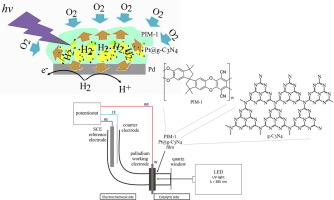Bioelectrochemistry ( IF 4.8 ) Pub Date : 2020-03-07 , DOI: 10.1016/j.bioelechem.2020.107499 Yuanzhu Zhao 1 , Joshua Dobson 1 , Catajina Harabajiu 1 , Elena Madrid 1 , Tinakorn Kanyanee 2 , Catherine Lyall 3 , Shaun Reeksting 3 , Mariolino Carta 4 , Neil B McKeown 5 , Laura Torrente-Murciano 6 , Kate Black 7 , Frank Marken 1

|
An “indirect” photo-electrochemical sensor is presented for the measurement of a mixture of analytes including reducing sugars (e.g. glucose, fructose) and non-reducing sugars (e.g. sucrose, trehalose). Its innovation relies on the use of a palladium film creating a two-compartment cell to separate the electrochemical and the photocatalytic processes. In this original way, the electrochemical detection is separated from the potential complex matrix of the analyte (i.e. colloids, salts, additives, etc.). Hydrogen is generated in the photocatalytic compartment by a Pt@g-C3N4 photocatalyst embedded into a hydrogen capture material composed of a polymer of intrinsic microporosity (PIM-1). The immobilised photocatalyst is deposited onto a thin palladium membrane, which allows rapid pure hydrogen diffusion, which is then monitored by chronopotentiometry (zero current) response in the electrochemical compartment. The concept is demonstrated herein for the analysis of sugar content in commercial soft drinks. There is no requirement for the analyte to be conducting with electrolyte or buffered. In this way, samples (biological or not) can be simply monitored by their exposition to blue LED light, opening the door to additional energy conversion and waste-to-energy applications.
中文翻译:

通过将Pt @ g-C3N4固定在具有固有微孔性(PIM-1)的聚合物中并附着在钯氢捕获膜上的碳水化合物进行间接光电化学检测。
提出了一种“间接”光电化学传感器,用于测量包括还原糖(例如葡萄糖,果糖)和非还原糖(例如蔗糖,海藻糖)在内的分析物混合物。它的创新依靠钯膜的使用来创建一个两室电池,以分隔电化学和光催化过程。以这种原始方式,将电化学检测与分析物的潜在复杂基质(即胶体,盐,添加剂等)分离。Pt @ gC 3 N 4在光催化室内产生氢光催化剂嵌入由固有微孔性聚合物(PIM-1)组成的氢捕获材料中。固定的光催化剂沉积在薄的钯膜上,从而实现快速的纯氢扩散,然后通过计时电位法(零电流)在电化学隔室中对其进行监控。本文证明了该概念用于分析商业软饮料中的糖含量。不需要分析物与电解质或缓冲液一起导电。通过这种方式,可以通过将样品(暴露于生物或非生物学的)暴露于蓝色LED灯来对其进行简单监控,从而为进一步的能量转换和废物转化为能源的应用打开了大门。











































 京公网安备 11010802027423号
京公网安备 11010802027423号